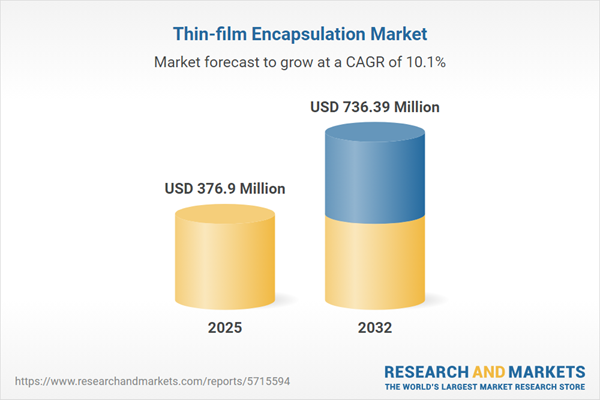Speak directly to the analyst to clarify any post sales queries you may have.
Thin-film encapsulation is rapidly becoming essential for manufacturers seeking enhanced performance and durability in flexible electronics and photovoltaic devices. By leveraging barrier technologies that enable reliable, next-generation applications, organizational leaders are well-positioned to capitalize on market trends and opportunities.
Market Snapshot: Thin-Film Encapsulation Market Growth and Trends
The Thin-film Encapsulation Market expanded from USD 342.07 million in 2024 to USD 376.90 million in 2025. It is projected to continue at a CAGR of 10.05%, with expectations to reach USD 736.39 million by 2032. This growth is fueled by increasing demand across consumer electronics, solar energy, and industrial sectors, driven by stringent reliability standards and evolving application requirements.
Scope & Segmentation: Technologies, Substrates, and Regions
- Deposition Type: Atomic Layer Deposition, Plasma-enhanced Chemical Vapor Deposition, Inkjet Printing, Vacuum Thermal Evaporation
- Substrate Type: Glass, Metal, Plastic
- Application: Flexible OLED Display, Flexible OLED Lighting, Thin-Film Photovoltaics
- End-Use Industry: Aerospace & Defense, Automotive, Consumer Electronics, Healthcare
- Region: Americas (including United States, Canada, Mexico, Brazil, Argentina, Chile, Colombia, Peru), Europe (United Kingdom, Germany, France, Russia, Italy, Spain, Netherlands, Sweden, Poland, Switzerland), Middle East (United Arab Emirates, Saudi Arabia, Qatar, Turkey, Israel), Africa (South Africa, Nigeria, Egypt, Kenya), Asia-Pacific (China, India, Japan, Australia, South Korea, Indonesia, Thailand, Malaysia, Singapore, Taiwan)
- Company Coverage: 3M Company, Aixtron SE, Ajinomoto Fine-Techno Co., Inc., AMS Technologies AG, Angstrom Engineering Inc., Applied Materials, Inc., BASF SE, Beneq Oy, Borealis AG, Coat-X SA, Encapsulix SAS, Ergis S.A., Kateeva, Inc., Kyoritsu Chemical & Corporation Limited, LG Chem Ltd., Lotus Applied Technology, Meyer Burger Technology AG, Saes Getters Spa, Samsung Electronics Co., Ltd., SNU Precision Co., Ltd, Tesa SE by Beiersdorf AG, Toppan Printing Co., Ltd., Toray Industries Inc., Universal Display Corporation, Veeco Instruments Inc.
Key Takeaways for Decision-Makers
- The thin-film encapsulation market is evolving through hybrid deposition techniques, which combine inorganic and organic layers for optimized performance in both rugged and lightweight applications.
- Material advances and process automation enable manufacturers to produce high-integrity barrier films on a wide range of substrates, supporting roll-to-roll processing and supporting scalability.
- Precision engineering of deposition workflows—such as spatially selective application and low-temperature processing—improves yield and enables tailored solutions for diverse industries including automotive and healthcare.
- Regional market dynamics require adaptive strategies, with localized production and partnerships fostering resilience and cost-competitiveness in response to supply chain volatility and regulatory shifts.
- Collaboration among manufacturers, OEMs, and research institutions accelerates innovation and facilitates rapid transfer of technology from concept to commercial-scale operations.
Tariff Impact: Navigating the 2025 US Tariff Developments
The introduction of US tariffs in 2025 has prompted organizations to reevaluate global supply chains and cost structures. Increased tariffs on precursor chemicals and equipment have made localization and alternative sourcing strategies more attractive. These adjustments, including reshoring and nearshoring of production, are strengthening supplier relationships and driving diversification. Manufacturers are using advanced forecasting, buffer stock strategies, and combinations of imported and domestic inputs to maintain operational continuity while adapting to changing regulatory environments.
Methodology & Data Sources
The report is developed using desk research, expert interviews, and data triangulation. Relying on technical journals, equipment datasheets, industry reports, and executive interviews, the methodology ensures high data quality and validation from multiple independent sources.
Why This Report Matters for Senior Leaders
- Enables strategic planning by mapping emerging technologies, regulatory shifts, and competitive landscapes specific to thin-film encapsulation.
- Delivers actionable insights to optimize manufacturing decisions, supply chain design, and partner selection across global regions.
- Supports leadership with a concise overview of segmentation and application relevance, aligned to next-generation electronics and energy solutions.
Conclusion
Thin-film encapsulation is critical for organizations seeking higher product longevity and market competitiveness. Adapting to new material and process innovations, while managing supply-chain complexities, will determine future industry leadership and success.
Additional Product Information:
- Purchase of this report includes 1 year online access with quarterly updates.
- This report can be updated on request. Please contact our Customer Experience team using the Ask a Question widget on our website.
Table of Contents
3. Executive Summary
4. Market Overview
7. Cumulative Impact of Artificial Intelligence 2025
Companies Mentioned
The companies profiled in this Thin-film Encapsulation market report include:- 3M Company
- Aixtron SE
- Ajinomoto Fine-Techno Co., Inc.
- AMS Technologies AG
- Angstrom Engineering Inc.
- Applied Materials, Inc.
- BASF SE
- Beneq Oy
- Borealis AG
- Coat-X SA
- Encapsulix SAS
- Ergis S.A.
- Kateeva, Inc.
- Kyoritsu Chemical & Corporation Limited
- LG Chem Ltd.
- Lotus Applied Technology
- Meyer Burger Technology AG
- Saes Getters Spa
- Samsung Electronics Co., Ltd.
- SNU PRECISION CO., LTD
- Tesa SE by Beiersdorf AG
- Toppan Printing Co., Ltd.
- Toray Industries Inc.
- Universal Display Corporation
- Veeco Instruments Inc.
Table Information
| Report Attribute | Details |
|---|---|
| No. of Pages | 194 |
| Published | November 2025 |
| Forecast Period | 2025 - 2032 |
| Estimated Market Value ( USD | $ 376.9 Million |
| Forecasted Market Value ( USD | $ 736.39 Million |
| Compound Annual Growth Rate | 10.0% |
| Regions Covered | Global |
| No. of Companies Mentioned | 26 |









